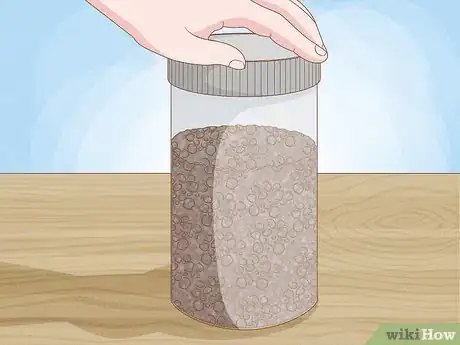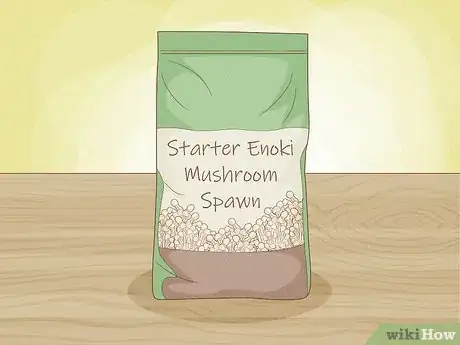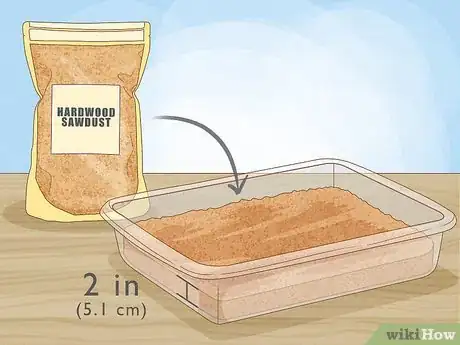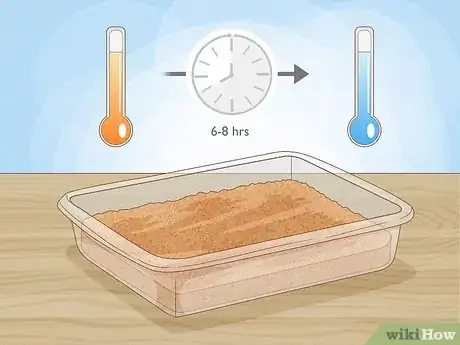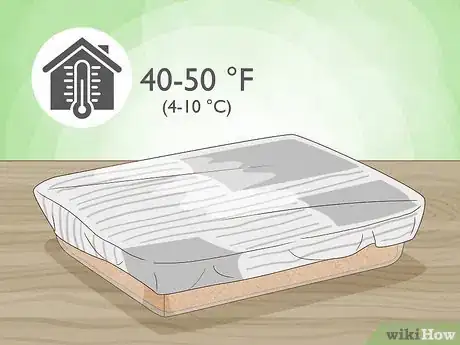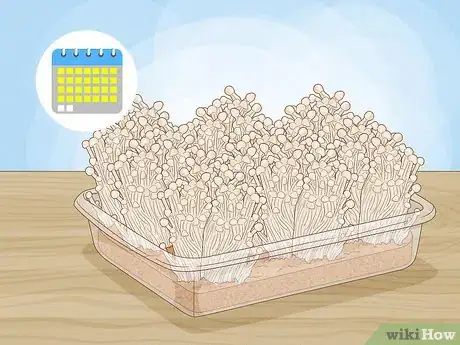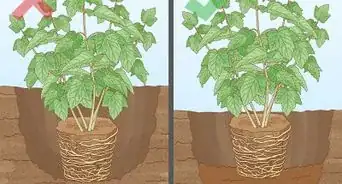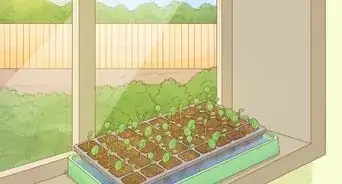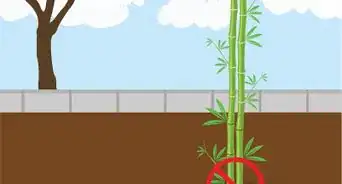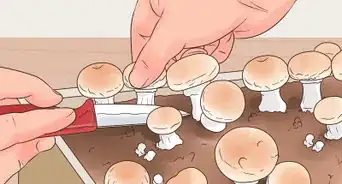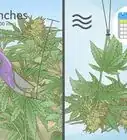This article was co-authored by Maggie Moran. Maggie Moran is a Professional Gardener in Pennsylvania.
There are 8 references cited in this article, which can be found at the bottom of the page.
This article has been viewed 60,716 times.
Enoki mushrooms are winter fruiting mushrooms with long white stalks and delicate pinhead caps. Growing your own Enoki mushrooms at home is easy, especially if you use a starter kit—all you have to do is wet the premade grow block, cover it, and stash it in a cool place until the mushrooms begin to emerge. You can also raise mushrooms from scratch by preparing your own substrate material and sprinkling it with starter spawn, which you'll then keep moist for 2-4 weeks.
Things You Should Know
- The easiest way to grow enoki mushrooms is using a starter kit.
- Starter kits come with premade grow blocks. You just add water, store the block in a dark place, and wait.
- It will take 2-4 weeks for your first set of mushrooms to grow.
Steps
Growing Enoki Mushrooms from a Starter Kit
-
1Purchase an Enoki mushroom starter kit. Mushroom starter kits are available online from websites that specialize in fungi. They most often come in the form of premade, ready-to-use grow blocks made of compacted substrate material like sawdust or straw. To begin growing the mushrooms, you simply wet and store the block.[1]
- You can expect to pay around $20-25 for a basic starter kit. The price may be higher depending on the seasonal availability of certain varieties of mushrooms.[2]
- A typical start kit contains enough materials to grow mushrooms continuously for 2-4 weeks.
-
2Drizzle 1 cup (240 mL) of filtered water evenly over the grow block. Your grow block should arrive inside an insulated plastic container or sleeve. Remove the lid of the container and pour the water directly over the top and sides of the block. Try to wet as much of the substrate material as you can.
- The more evenly you wet the grow block, the more area the mushrooms will have to begin growing.
- Your grow kit may specify a different amount of water, depending on the size of the block and the mushrooms' specific moisture requirements.
- Use filtered or distilled water, as tap water is treated with chemicals.
Advertisement -
3Cover the grow block container with a lid or plastic bag. If your container didn't come with a removable lid, drape a grocery bag or gallon-sized zipper bag lightly over the opening. This will help trap moisture inside, making it an optimal environment for speedy growth.
- Don't seal off or pin down the edges of the bag. Your mushrooms will need some air in order to grow.
- You can also use a couple wet strips of newspaper (or any other kind of lightweight paper) if you don't have a plastic bag on hand. Just make sure the saturated newspaper isn't heavy enough to weigh down the mushrooms as they emerge.
-
4Keep the grow block in a cool, dark place. Situate the covered container somewhere where it can remain at a constant temperature of 40–50 °F (4–10 °C). A shelf on your refrigerator or a dim basement or pantry will work well. You could also leave your grow block in a shady spot outside, as long as temperatures don't drop below freezing.[3]
- If you don't have a suitable cool place to keep your grow block, simply set it on the kitchen counter. Enoki mushrooms are a cold weather species of mushroom, but they'll also grow just fine at room temperature.[4]
-
5Wait 2-4 weeks for the first batch of mushrooms to appear. First, a fuzzy white substance called mycelium will appear on the outside of the block. Soon after, the mushrooms themselves will begin to pop up. Once the small caps are fully formed, they'll be ready to harvest for cooking or propagation.[5]
- Between the wood contained in the grow block and the moisture-trapping plastic, your mushrooms will have everything they need to flourish, so there should be no need to uncover them until they start fruiting.
Cultivating Enoki Mushrooms from Spores
-
1Buy a packet of starter Enoki mushroom spawn. You can get mushroom spawn through an online vendor that sells fungi spores, as well as some agriculture supply stores and greenhouses. Unlike a complete starter kit, mushroom spawn contains only the spores themselves, which usually come packed into a protective housing material like sawdust.[6]
- Enoki mushrooms are sometimes listed as “Enokitake” on specialty websites. “Take” is the Japanese word for “mushroom.”[7]
- Starter spawn doesn't include instructions, which means you'll have to learn how to cultivate and tend the mushrooms yourself. If this sounds like too much work, you may be better off using a starter kit instead.
-
2Acquire some hardwood sawdust or a similar growing material. Enoki mushrooms are decomposers that can grow in any number of organic substrates, but they tend to favor hardwood sawdust. However, you'll also get successful results using straw or ordinary garden compost. Stock up on enough substrate material to create a bed about 2 inches (5.1 cm) thick so your spores will have plenty of room and resources to grow.[8]
- You'll generally find raw substrate materials for sale at the same place where you bought your starter spawn.
- Any type of sawdust or wood chips will work, as long as they're collected from hard wood.[9]
-
3Pasteurize the substrate material by heating it to 160–180 °F (71–82 °C). Transfer the substrate to an oven bag or pan with steep sides and place it in an oven preheated to 300 °F (149 °C). Warm the sawdust, wood chips, straw, or compost for 1-2 hours. Once it reaches roughly 180 °F (82 °C), reduce the temperature of the oven to 180 °F (82 °C) and continue heating for 3 hours.[10]
- Use a meat thermometer to find the temperature of the substrate material every 15-20 minutes.
- Avoid heating the substrate past 180 °F (82 °C), as this will also kill off organisms that are beneficial to the mushrooms.
-
4Allow the substrate material to cool for 6 to 8 hours. After pasteurizing the substrate, remove the bag or pan from the oven and set it on a heat-safe surface to cool. It should be left to sit at room temperature for several hours before you begin adding the spores.[11]
- At this point, you can transfer your substrate to your desired growing container, or proceed to raise your mushrooms right in your oven bag or pan.
- Introducing the cold-loving mushroom spores to the substrate while it's still hot could kill them.
-
5Spread the mushroom spawn over the substrate material. Try to distribute the clumped spores evenly over the surface of the substrate. Once they've been added, they'll feed on the pulpy wood and the moisture it contains and begin producing mycelium within a few days.[12]
- Check the packaging of your starter spawn for more precise information on how much to use.
- It may take up to a week after you first sew the spawn for the mycelium to appear.
-
6Cover the growing container. Place a plastic bag or layer of wet newspaper over the spawn-infused substrate. This will provide the spores with a ready supply of moisture, which they'll soak up to grow larger in less time.[13]
-
7Keep your growing container at room temperature or cooler. Designate a shelf in your refrigerator for your Enokis, or create some space on a countertop or in your pantry. Ideally, they should stored at around 40–50 °F (4–10 °C), but they'll also grow without difficulty (albeit a bit slower) in temperatures up to about 75 °F (24 °C).[14]
- A growing location like a basement or cabinet beneath the sink is ideal, as these places are often humid as well as cool.
- Whatever spot you choose, make sure it's well-shaded. Enoki mushrooms can tolerate a little bit of light, but too much can stunt their growth or even cause them to die off.
-
8Mist the substrate material with water twice a day. Pull back the plastic or newspaper and spritz the surface of the substrate material lightly with a spray bottle filled with cold, fresh water. Do this once in the morning and again in the evening. There's no need to wet the substrate too thoroughly—just give it a couple sprays and replace the cover.[15]
- Be careful not to oversaturate the substrate. Doing so could drown out young mushrooms or lead to the growth of harmful bacteria.
-
9Give the mushrooms 2-4 weeks to reach maturity. When kept covered, cool, and moist, your first crop of Enoki mushrooms should spring up in no time. Mushrooms grow faster than almost any other food source, and can actually double in size every day.[16]
- In some cases, it may only take a little over a week to end up with a batch of full-sized mushrooms.
- If your mushrooms seem to be developing slowly, try lowering their surrounding temperature as much as possible to simulate their preferred natural environment.[17]
Warnings
- It may not be safe to consume Enoki mushrooms if you suffer from a mushroom allergy.⧼thumbs_response⧽
- Thoroughly rinse your mushrooms before you eat or cook with them.⧼thumbs_response⧽
Things You'll Need
- Enoki mushrooms starter kit
- Enoki mushroom spawn (optional)
- Hardwood sawdust, wood chips, or similar substrate material
- Oven bag or pan with steep sides (to serve as growing container)
- Plastic bag
- Newspaper (optional)
- Spray bottle
References
- ↑ https://www.bhg.com/gardening/vegetable/vegetables/how-to-grow-mushrooms/
- ↑ https://www.mushroom-appreciation.com/mushroom_growing_kits.html
- ↑ https://www.bhg.com/gardening/vegetable/vegetables/how-to-grow-mushrooms/
- ↑ http://www.naturallivingideas.com/how-to-grow-mushrooms-at-home/
- ↑ http://www.ostrommushrooms.com/varieties/enoki/how-they-grow
- ↑ http://www.naturallivingideas.com/how-to-grow-mushrooms-at-home/
- ↑ http://www.medicalmushrooms.net/flammulina-velutipes-enokitake/
- ↑ http://www.naturallivingideas.com/how-to-grow-mushrooms-at-home/
- ↑ https://fungiforthepeople.org/2013/12/15/enoki-flammulina-velutipes/
- ↑ http://www.naturallivingideas.com/how-to-grow-mushrooms-at-home/
- ↑ http://www.naturallivingideas.com/how-to-grow-mushrooms-at-home/
- ↑ https://www.youtube.com/watch?v=irjwX3qgtTg&feature=youtu.be&t=89
- ↑ http://www.naturallivingideas.com/how-to-grow-mushrooms-at-home/
- ↑ https://www.bhg.com/gardening/vegetable/vegetables/how-to-grow-mushrooms/
- ↑ http://www.naturallivingideas.com/how-to-grow-mushrooms-at-home/
- ↑ https://www.mushroomcouncil.com/how-mushrooms-grow/
- ↑ http://www.ostrommushrooms.com/varieties/enoki/how-they-grow


